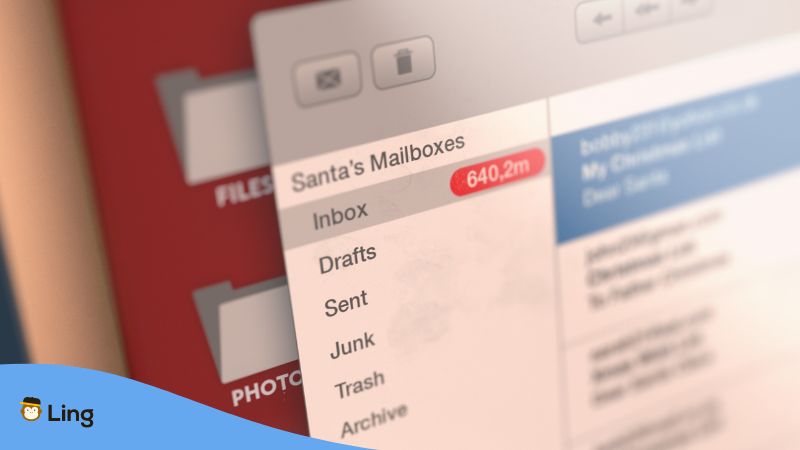Sending someone an email in Tagalog? Well, start learning these easy Filipino email phrases today!
Sending an email is literally one of the everyday routines of people nowadays. People are mostly familiar with composing an email but it’s harder when you do it in different languages. Learning some Filipino email phrases will help you talk to your friends, do, business, and more. If you know some basic vocabulary in sending an email, you’ll learn how to express your thought to the locals with politeness. By learning this, you may not ask the question, “What is [word] in Tagalog?” (Ano sa Tagalog ang [salita]?)
In the Philippines, the word email is not really translated but there is a Filipino translation for that which is sulatroniko – sulat means letter while troniko came from elektroniko means electronic. But, today, we will go deeper into the different Filipino expressions and phrases used in email.
Opening – Pambungad na Linya/Pahayag

The first group of Filipino email phrases is the opening lines. Before that, you have to know that Filipinos tend to use the plural form of the pronoun you like kayo and ninyo instead of ka, mo, or ikaw. This is another way of showing respect in writing.
Good Morning – Magandang umaga!
Greetings are really important. So, these Filipino expressions are essential to learning. Remember, never say “Hi”, “Hello”, or Kumusta ka?/ Kamusta ka? (How are you?) to avoid sounding informal. These words are also discussed in the blog post “Basic Filipino Phrases” if you want to check them out.
When sending an email, you have to ensure that you’re sending it at an appropriate time, and mostly, we send emails in the morning. In the Philippines, work hours usually start at 8:00 am. A company called Sendinblue found that 10 a.m. and between 3 and 4 p.m. are good times to send emails. This may not be a big surprise because at 10 a.m. most people are already at work and trying to get things done. Eventually, they’ll check their email and read their unread messages.
Other Filipino phrases for greetings are:
- Good day! – Magandang araw!
- Good day!/Greetings! – Mabuhay!
- Good evening – Magandang gabi!
- Good Afternoon – Magandang hapon!
- Happy birthday! – Maligayang kaarawan
Mr./ Ms./ Mrs. – Ginoo (G.)/Ginang (Gng.)/ Binibini (Bb.)
When doing greetings, do not forget to add the name of your recipient. It is also important to put honorifics before the name. Here is the translation of these honorifics in the Tagalog language.
- Mister (Mr.) – Ginoo (G.)
- Miss (Ms.) – Binibini (Bb.)
- Missus/Missis (Mrs.) – Ginang (Gng.)
Hope you are doing well. – Sana ay nasa mabuti kayong kalagayan.
After the greetings, you need to have an opening line. By doing this, you’ll sound more polite. One of the Tagalog phrases that is used as an opening line is “Sana’y nasa mabuti kayong kalagayan.” This phrase is an act of politeness because it means that you’re wishing your email recipient to do well.
Hope you’re enjoying your vacation. – Sana’y masaya ang inyong bakasayon.
Another polite opener is saying, “Sana’y masaya ang inyong bakasyon.” There are times when you need to send an urgent email to someone during breaks or the holiday season, so to be respectful, you may use the phrase “Sana’y masaya ang inyong bakasyon.”
My name is [insert your name] – Ang pangalan ko po ay [ilagay ang pangalan]
After the opening lines, you also need to introduce yourself. This should also be followed by more information about you like your title, occupation, or any information that will give the reader a clear idea of who you are.
I am reaching out to you because… – Ako po ay nakikipag-ugnayan sa inyo dahil …
After you introduce yourself, you need to state your purpose. The easiest way to say that is “Ako po ay nakikipag-ugnayan sa inyo dahil …” then, it should be followed by your purpose. Some of the common purposes why people send an email are:
- I want to ask for an update about my request. – Nais kong humingi ng balita tungkol sa aking ipinakikiusap/hinihiling.
- I want to inquire about the job. – Nais kong magtanong tungkol sa trabaho.
- I want to ask for clarification. – Nais kong humingi ng paglilinaw.
- I wanted to let you know that… – Nais ko pong ipabatid na …
- This is just to remind you … – Nais ko pong ipaalala…
Body

After the opening lines, let us move to the body of the email. This is where the most important part of the email is. This includes Filipino email phrases about attachments, requests, asking or giving approval, sharing bad news, scheduling, and more.
Attached here is the … Kalakip dito ang dokumentong …
There are times when we need to send an email with attachments, so to verbalize it, you can just say “Kalakip dito ang dokumentong (Attached here is the [name of the file]. )” Make sure to attach your file before sending because people tend to forget this fundamental step.
Could you please…? – Maaari bang …
This is one of the most common Filipino email phrases to use when you’re requesting something. “Maaari bang..?” means “Could you please…?”. You can add your real request after this phrase.
Could you give us some more details on…? – Maaari niyo po bang bigyan kami ng ilang karagdagang detalye sa…?
If you’re asking for more details about something, you can use the phrase “Maaari niyo po bang bigyan kami ng ilang karagdagang detalye sa…?”. After the sa you should add the information you want to know.
Thank you for letting me know. – Salamat sa pagpapabatid sa akin.
This phrase is usually a reply when you received an email from someone informing you about something like they are going to be absent. It can also be a way of letting you know important information that you need to know.
Please let me know what you think about this. – Mangyaring ipaalam sa akin kung ano ang iyong opinion tungkol dito.
This Filipino email phrase is commonly used when asking for opinions and approval from your colleague, boss, or person of authority. This is also an act of respect for the other person.
I’d like to schedule a meeting on [day] if you are available/free then. – Nais kong magtakda ng isang pagpupulong sa [araw] kung may bakante po kayong oras.
If you want to schedule a meeting with someone, this is an easy way to do it. Just say, “Nais kong magtakda ng isang pagpupulong sa [insert the date] kung may bakante po kayong oras.” The line “Kung may bakante po kayong oras” is also an act of politeness because you’re asking to do the meeting if their time permits.
We regret to inform you that… – Ikinalulungkot kong ipabatid na…
This Filipino email phrase is a respectful way to give negative news to someone like a rejected request and more.
Closing

Closing an email properly is also as important as properly opening an email. Here are the lines that you may use to close an email properly:
Looking forward to hearing from you soon. – Inaasahan ko ang inyong tugon sa lalong madaling panahon.
This is the most common way to close the email politely and ask for a response. You’re asking for an immediate response without sounding too assertive or pressuring.
Thank you so much. – Maraming salamat po.
Of course, you should never forget to say, “Thank you.” This is indeed one of the very popular and essential Filipino phrases that you should learn.
Pagpalain! – God bless!
This is also a greeting used to end an email. The Philippines is one of the largest Catholic countries in the world so you might often see this as a closing Filipino email phrase.
Respectfully, – Gumagalang,
Lastly, we also need to learn how to say the common end greeting, “Respectfully,” because this is usually used in an email.
Other Filipino Email Phrases
You might have known many Filipino email phrases above but here are more to add to your vocabulary.
Tagalog Phrases for Opening Lines
| English | Tagalog |
| I hope all is well. | Sana ay maayos ang lahat. |
| It was a pleasure to meet you yesterday. | Ikinagagalak kong makausap kayo kahapon. |
| I hope you had a great trip. | Sana ay naging maganda ang inyong paglalakbay. |
Filipino Phrases For Stating Your Purpose
| English | Tagalog |
| I am writing to you about our last meeting/your presentation yesterday/our next event | Sumulat ako sa inyo tungkol sa ating huling pagpupulong/ presentasyon kahapon/ susunod nating gawain |
| I am writing to formally ask/inquire about… | Sumulat ako upang pormal na magtanong tungkol sa… |
| I am contacting you to inform… | Nakikipag-ugnayan ako sa inyo upang ipaalam… |
Replying – Pagtugon
| English | Tagalog |
| I just got your request for… | Katatanggap ko lamang ng iyong hiling/pakiusap tungkol sa… |
| I just read your email about… | Kababasa ko lamang ng iyong email tungkol sa … |
| Thank you for your email about… | Salamat sa iyong email tungkol sa… |
| Thank you for reaching out (to me). | Salamat sa pakikipag-ugnayan (sa akin). |
| Thanks for your quick reply. | Salamat sa iyong maagap/mabilis na tugon. |
| You’re welcome | Walang anuman |
Apologizing – Paghingi Ng Paunmanhin
| English | Tagalog |
| Sorry for my late reply. | Paumanhin sa huling pagtugon. |
| Sorry that it took me so long to get back to you. | Paumanhin kung natagalan ang making pagtugon. |
| Sorry it’s been so long since my last email. | Paumanhin kung matagal bago nasundan ang huli kong email. |
| I was sorry to hear about… | Ikinalulungkot kong mabatid ang tubgkol sa … |
Attachments And Information – Mga Kalakip na Dokumento At Impormasyon
| English | Tagalog |
| Please the read attached [file]. | Pakitingnan ang nakalakip na dokumento. |
| I’ve sent [file] for your review. | Nagpadala ako ng isang dokumento na maaari ninyong suriin. |
| Could you please sign the attached form and send it back to us by [date]? | Maaari mo bang pirmahan ang kalakip na dokumento at ipadala ito sa amin bago ang [petsa]? |
| The attached file contains… | Ang kalakip na dokumento ay naglalaman ng … |
Requests And Inquiries – Mga Pakiusap/ Kahilingan at Katanungan
| English | Tagalog |
| I’d really appreciate it if you could… | Ikalulugod ko kung … |
| It would be very helpful if you could send us/me… | Malaking tulong kung maipapadala ninyo sa amin/sa akin … |
| Please find my two main questions below. | Mangyaring bigyang-pansin ang aking dalawang pangunahing katanungan sa ibaba. |
| I didn’t/don’t fully understand [something]. Could you please explain that again? | Hindi ko/hindi ko lubos na naintindihan [ang isang bagay]. Maaari niyo bang ipaliwanag muli iyon? |
| Could you please clarify the …? | Maaari mo bang linawin ang…? |
| If I understood you correctly, you would like me to… | Kung tama ang making pagkakaintindi, nais niyong … |
| Could you explain what you mean by …? | Maaari mo bang ipaliwanag ang …? |
| In other words, would you like us to… | Sa madaling salita, nais niyo po kaming … |
Sharing Information – Pagbabahagi ng Impormasyon
| English | Tagalog |
| Thank you for the heads up | Salamat sa paunang sabi. |
| I’d like to inform you that… | Nais kong ipabatid na … |
| Just a quick reminder … | Isang paalala lamang… |
Asking And Giving Approval – Paghingi At Pagbibigay ng Permiso
| English | Tagalog |
| What are your thoughts (on this)? | Ano ang iyong mga saloobin (tungkol dito)? |
| Please let me know if this is OK with you. | Mangyaring ipaalam kung ito ba ay ayos sa iyo. |
| We’re just waiting for approval | Hinihintay lamang namin ng inyong permiso. |
Scheduling – Pagtatakda
| English | Tagalog |
| I am available on [day], if that’s convenient for you. | Puwede ako sa araw ng [araw], kung ikaw ay puwede rin. |
| Can you make it on [day]? | Makakarating ka ba sa [araw]? |
| I’m afraid we need to reschedule/delay the … | Ikinalulungkot kong kailangan nating ipagpaliban ang … |
| We are sorry to inform you that the interview/meeting scheduled for [day] will have to be rescheduled. | Ikinalulungkot naming ipaalam sa inyo na ang panayam/pagpupulong na naka-iskedyul para sa [araw] ay kailangang muling iiskedyul. |
Giving Bad News
| English | Tagalog |
| Unfortunately, … | Sa kasamaang palad,… |
| Despite my best efforts, … | Sa kabila ng aking pagsisikap,… |
| Due to [reason], it won’t be possible to… | Dahil sa [dahilan], hindi posible na… |
| After careful consideration, we have decided (not) to … | Pagkatapos ng maingat na pagsasaalang-alang, nagpasya kaming (hindi) … |
Closing
| English | Tagalog |
| I hope you find this helpful. | Nawa’y ay nakatulong ito sa iyo. |
| I look forward to seeing/meeting you. | Inaasahan kong makilala kayo. |
| Thank you in advance. | Paunang pasasalamat. |
| Any feedback you can give me on this would be greatly/highly/much appreciated | Anumang tugon tungkol dito ay lubha kong ikalulugod. |
| I would appreciate your help in this matter. | Ikalulugod ko ang inyong pagtulong tungkol dito. |
| If you could have it ready by tomorrow/the end of next week, I would really appreciate it. | Kung maihahanda mo ito bukas/sa katapusan ng susunod na linggo, lubha ko itong ikalulugod. |
| I hope it’s clearer now. | Nawa’y malinaw ito’y nabigyang-linaw. |
| I hope that answers all your questions. | Nawa’y nasagot ang lahat inyong katanungan. |
| If we can be of any further assistance, please let us know. | Kung may maitutulong pa kami, ipabatid lamang sa amin. |
| … please do not hesitate to contact me. | … mangyaring huwag mag-atubiling makipag-ugnayan sa akin. |
| For further details… | Para sa karagdagang detalye… |
| Yours truly | Sumasaiyo |
| Thank you | Salamat |
Filipino Email Vocabulary
| English | Tagalog |
| Search Mail | Maghanap sa email |
| Compose | Mag-email |
| New Message | Bagong Mensahe |
| Recepients | Para Kay |
| Subject | Paksa |
| Send | Ipadala |
| Schedule | Mag-iskedyul ng pagpapadala |
| Inbox | Inbox |
| Sent | Naipadala |
| Starred | May bituin |
| Snoozed | Naka-snooze |
| Important | Mahalaga |
| Drafts | Mga draft |
| Categories | Mga kategorya |
| Social | Social |
| Updates | Mga Update |
| Forums | Mga Forum |
| Promotions | Mga Promotion |
Got An Email Address? Create Your Ling Account Now!

Wanna start your language-learning journey? Well, you’re just one step away. You can just use your email to start your account and begin your first language lesson with the Ling app. Fun, exciting, and meaningful, who wouldn’t want their language-learning journey to be like that? Good thing, Ling app can give you that experience. Develop and practice your language skills like writing and speaking and achieve fluency in record time.
Compose more than just emails. Learn Tagalog with Ling app now!



































































